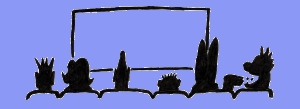Producing an AV Sequence (Part 4)
Selecting and editing music
The music I choose for my sequences is invariably chosen as background music to create a mood, although I recognise that some producers choose the music to 'drive' the sequence even though the sequence may have script.
Normally I would not choose a song as background music where script is used because the listener's attention would be divided between the words of the song and those of the sequence, which would be too distracting. However, in the case of my Welsh based sequences, I use male voice choral pieces to set the mood. The Welsh words will have no meaning to English ears therefore there is no distraction. To me, the words of the song or hymn are very important and are 'right' for what I want to achieve.
Another technique, used in The Survivors, was to choose two distinctly different pieces of music to represent the two characters in the sequence. In the sections devoted to Emrys Williams' life story some contemporary, forceful, dramatic action music was chosen, in keeping with his experiences. In contrast, for the Pole, Stefan Maslowski, Mozart's Sinfonia Concertante K 364 was chosen. The piece is reputedly a requiem for Mozart's mother but nevertheless a requiem and the mood and pace is again in keeping with his experiences. Stefan Maslowski was forced to play his violin in the Auschwitz camp orchestra which was allowed to play only German or Aryan music. His father, a viola player, was sent to the gas chambers. The additional significance of the choice of this piece, which was written for violin and viola, is that it is played by the Oistrakhs, father and son, just like Stefan Maslowski and his father.
I listen carefully to how background music is used to set the mood in television drama series and films. Even the piano accompaniment to silent movies let you know when to hiss and boo!
Unless I have specific requirements, as already stated, I prefer to avoid classical music. Firstly, the fluctuation between loud and quiet passages makes it difficult to control the recording levels. Secondly, the listener may already have preconceived ideas of the images relating to the music and these may not match what the producer is trying to convey. For example, I was intending using Carl Orff's Carmina Burana for a dramatic section of a sequence I was making, then a Dutch friend of mine pointed out that the music was widely used in Europe for a coffee advert!
I prefer to use mood music specifically produced for AV or film purposes. Companies such as Boosey and Hawkes, KPM, Soniton and many others have a wide range of CD's available to IAC members who hold the necessary licences to use copyright music (see Copyright and Music Advisory Service ). These CD's consist of anything up to 50 short tracks, lasting from a few seconds to several minutes, with suitable editing points. They may include tracks produced by different composers but generally the music, on each CD, is played by the same instruments and the tracks are therefore compatible.
I choose music to suit each individual section of the sequence. The music is matched to the mood I am trying to create, backed up by the visual impressions created by the images. The music editing is done in Cool Edit on a pc. This program has now been replaced by Adobe Audition .
The music is chosen according to its suitability rather than its length and is edited as necessary.
The music is made to fit the required time by editing at suitable cutting points. Where two short extracts of music need to be joined, the change from one piece to the next is achieved by cross-fading. By cross-fading I mean laying down one piece of music on track 2, in stereo, and the next piece of music on track 3, again in stereo, with say a four second overlap between them. The Cool Edit 'envelopes' are used at the overlap point to fade out track 2 and fade in track 3. To make the transition as smooth as possible on the ears, I hide the join, if possible, behind a section of the recorded voice. The voice is always laid down on track 1, in stereo. This process will be repeated when necessary throughout the sequence using other available tracks.
Dependent upon the number of mood changes I may have quite a number of music changes in the sequence. I also make use of sound effects to add further to the atmosphere.
< Back to start < Previous Next >

